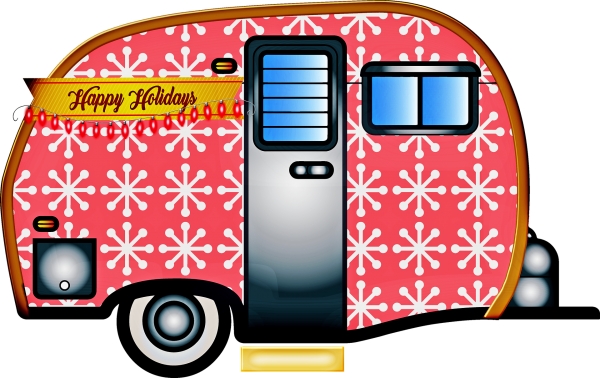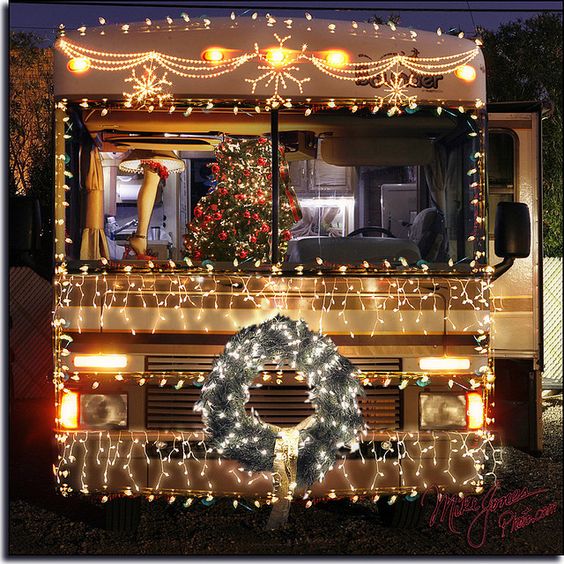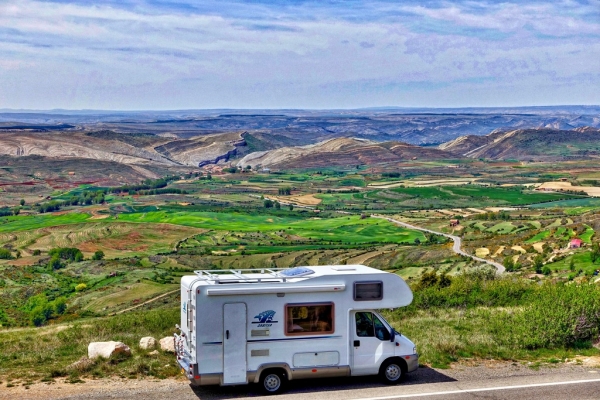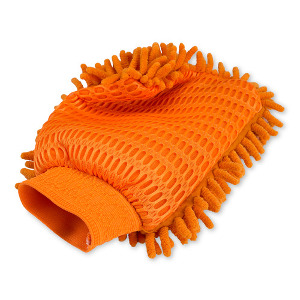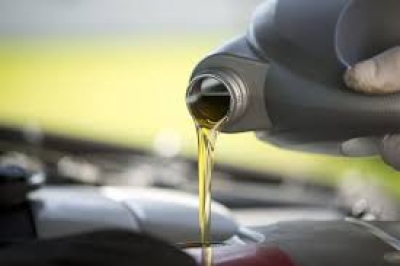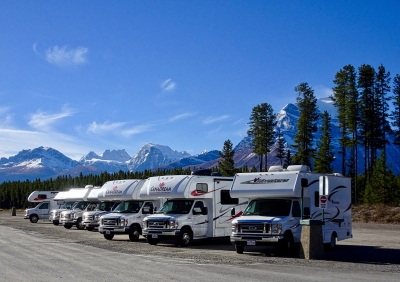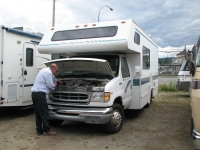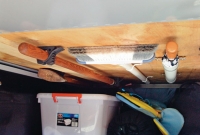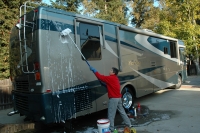Welcome to Crossing Creeks RV Resort & Spa in the heart of iconic Blairsville

Your RV (25)
Ready to get your RV into the holiday spirit? Here are some ideas.
It’s easy and affordable to imbue your trailer or motorhome with Christmas spirit.
 Giftwrap Your Kitchen Cabinets
Giftwrap Your Kitchen Cabinets
Nothing says Christmas like presents, so why not use that motif where you can in your RV?
Kitchen cabinet doors are a great place. They’ve got that Christmas-present rectangular shape. Their transformation into gifts concentrates on the doors.
You can just add ribbon and stick-on bows to the doors to dress them up in holiday style. Wrap the ribbons over the edge of the doors and tape them to the insides of the doors, or use a few tacks—as few as possible. If the bows won’t stay in place, use a paper stapler to fasten them to the ribbon.
Make a bigger splash by using rolls of wrapping paper to add color. Solid colors may be the best choice here; patterns can overwhelm. Use the paper—maybe a red or green, or a sparkly version—to wrap each door. Leave the smooth, full covering on the outside. Fasten with transparent tape or tacks inside. Fold the wrapping paper over the edges of the door and crease it at the edges so it lies flat more readily.
After the paper is on, you can apply the same ribbon-and-bow treatment mentioned above. Now, that’s a Christmas gift look.
Add Greenery
If you have the floor space for a tree, wonderful! It doesn’t have to be—and maybe shouldn’t be—too tall if you’re traveling, so it doesn’t tip over. If you’re here at the resort for the holidays, just set it up as you would in a bricks-and-mortar home. If you’ll be traveling, screw the tree stand onto a carpet-covered plywood cutoff, maybe 3x3 feet. Set the plywood on no-slip drawer liner so it doesn’t wander when traveling. It’s also good to tether the tree with string and thumbtacks before you move.
No room for a tree? No problem. Try stringing green garland—natural or artificial—along a wall. Natural will provide a holiday scent. Make sure there’s slack between connection points so it bows a bit toward the floor. You may not want to screw into your RV walls to do this, so use clear or white no-screw picture hangers every few feet. They’re cheap, they’ll get the job done, and they remove easily when you pull on a tab after the holidays.
Whether you have a tree or garland for greenery, add some mini LED lights—white or colors—to liven them up, and some small ornaments. You can even find RV-themed ornaments. If you plan to drive with the decorations up, choose modestly sized ornaments and use green or black tie wraps to attach them, rather than metal hooks. Some big red or white velvet bows add a tasteful pop. String white or colored LED bulbs through the garland.
Outside: Light it up!
If you live in a park, make sure you stay within the rules for outdoor holiday decorations.
An easy way to add nighttime decorations is with a laser light that projects against the side of your RV. Lights that project red and green dots are common, but these days additional colors are available. Many laser projectors offer a menu of shapes, often including holiday-related shapes—holly leaves, trees, stars, angels. Some laser projectors are dedicated to holiday shapes. You can set the projectd shaps to be stationary or to move. You’ll need a lasr light approved for outdoor use and an outdoor-rated power cord. Tips for decorating inside can work outside, too. A tree with lights at your site is tasteful and fun, and garland and/or a string of LED lights can be temporarily strung on your RV exterior for holiday flavor. The wrapping technique can work on your RV door just as easily as on cabinets, as long as you’re not traveling. You can buy weatherproof holiday door wraps, which you’ll have to trim to size for your RV. If you use paper, make sure the roll is long enough to go the length of the door, then cover with clear plastic. A traditional wreath is always fashionable—and removable when you roll.
Wreath decals are also available. As are decals with other holiday images and messages. They eliminate having to remove them when you travel.
Happy holidays, everyone!
photo credits: Pinterest
Bug splatter is a real problem with summer and fall driving, and the longer you wait to get the bugs off your RV, the more difficult it will be. Absolutely get rid of them before winter.
Even more aerodynamic RVs are like bricks on wheels. They’re bound to catch a lot of bugs, especially in Southeastern states, including Georgia. One look through a splattered windshield on your way to or from Crossing Creeks RV Resort and Spa in Blairsville gives you a good idea of what the bugs do to the painted front ends of your RV. They may not show as readily on paint as on a clear windshield, but the bugs are there.
Let’s look not just at how to get dead bugs off your RV finish, but also how to lessen the likelihood that they’ll become a real mess in the first place.
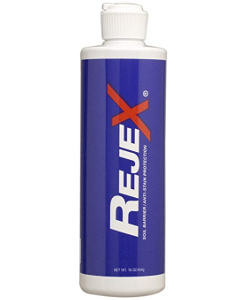 Preventing Insect Sticking
Preventing Insect Sticking
You can’t escape bug splatter, but you can reduce just how much bugs stick to paint and decals.
The best defense is to do something you ought to do anyway to maintain the value and appearance of your RV: Keep it washed and waxed. Any high-quality wax will provide a protective layer against insects.
There are other preventive products, too. RejeX Polymer Coating, for instance, coats paint and decals with a micron-thin shield. Originated to protect airplanes, it’s glossy like wax, so you can use it alone on the front of your RV. Wax or RejeX make it easier to wipe off insect residue, but wax and RejeX don’t mix, so don’t use them together on the same area. Rejex can also be used on headlight covers and windshields. Photo credit: Rejex.com.
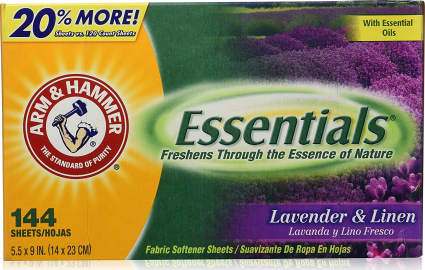 Bug Splatter Removal With Dryer Sheets
Bug Splatter Removal With Dryer Sheets
One of the traditional methods, but one that’s highly effective, is to use drier sheets—yes, the same sheets you throw in the drier to soften clothing. Do this in the shade or at least on the cool side of the RV, away from direct sunlight.
For bug removal, place a dryer sheet in a spray bottle and fill it with water. Spray the mixture onto the bugs and wipe off with—what else?—another dryer sheet. You may have to repeat, but the method gets the job done.
When you’re finished, wash and apply a new coating of wax or sealant. Photo credit: ezvidwiki.com.
Scrubbing Off Bugs
Some automotive washing mitts do a good job of scrubbing off dead bugs. A good example is the Griot’s Garage Micro Fiber Wash & Scrub Mitt. Use a bucket of water mixed with the cleaning agent you normally use to wash your RV. The mitt soaks up plenty of water for a thorough wash.
One side of the mitt has tendrils of micro fiber for routine RV washing. The other side is textured with plastic edges for bug removal. The honeycomb on the textured side bites into bug splatter and helps to remove bug residue without scratching paint. You’ll still have to scrub, and possibly repeat. Photo credits: Griot's Garage.
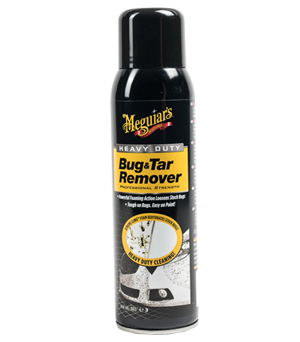 Chemical Bug Removers
Chemical Bug Removers
Chemical cleaners—Maguiar’s Heavy Duty Bug & Tar Remover is an example—are formulated to soften bugs so they can be wiped off. You know Maguiar’s is working when it foams on the surface. Different cleaners may give different results. A soft rag or sponge should do for scrubbing, if necessary. When using any chemical cleaner, it’s a good idea to use latex gloves to limit exposure to your skin.
The makers of chemical cleaners say they engineer their cleaners so they don’t harm finishes, but it’s always a good practice to follow a vigorous chemical bug cleaning with a thorough wash. Apply a new coat of wax to keep more bugs from sticking. Photo credit: Meguiar's.
Some RV owners swear by dry washes, such as Aero Cosmetics Wash Wax All. You can use it in some RV parks that ban washing with water. You can also use it during stops while traveling. Spray it on, let it work in to soften the bugs, and wipe off with a micro fiber cloth. For stubborn splatters, scrub with a wet cloth before wiping dry. It leaves a slick sheen that will help to prevent future insect sticking.
Any RV has fluids that need to be changed periodically and disposed of properly.
Fluid change requirements in an RV don’t differ significantly from those of a car or SUV you drive every day. The biggest difference may be the number of miles driven. If your RV is on the road for only 3,000 or 4,000 miles each year, you may not reach the change intervals in terms of miles, but you should still change the fluids periodically, and the filters along with them.
A motorhome has more fluids: motor oil, antifreeze/coolant and hydraulic fluid. An RV trailer may have only the hydraulic fluid.
Here are some fluid-change guidelines.
Motor oil
This is the lifeblood of your engine. Oil must flow freely to bathe moving internal engine parts. Oil lowers friction and heat, reducing wear. For oil to flow freely, it must be relatively clean, be the right weight for your vehicle and have a clean filter. All that information is available in the owner’s manual. A service department also will know it.
Generally speaking, an oil and filter change every 4,000 to 5,000 miles is sufficient. But certain conditions place additional stresses on oil and may call for more frequent changes: towing; driving under heavy loads, in extremely hot weather, and in high altitudes; and idling for long periods.
If you don’t travel as many miles as are recommended for oil changes, change the oil yearly.
If you change the oil yourself, buy a pan to catch the old oil. Save it for recycling. (More on that later.)
Transmission Fluid
The difference of opinions on transmission oil changes is wide. Check your owner’s manual. Some sources say 100,000 miles; some say 50,000 miles. If you tow a trailer, your pickup’s tranny fluid should be changed under the “severe service” schedule, which would be more frequently. The Chevrolet Silverado “severe service” recommendation, for example, is every 45,000 miles. If you purchased an independent, extended warranty, check to make sure it does not require more frequent intervals.
It’s pretty safe to say that motor home transmission fluid should be changed under the severe schedule as well, since it’s powering thousands of extra pounds.
As a rule, check your transmission fluid seasonally, using the transmission dipstick, with the engine running. If the level is full, and if the liquid is clear and is its normal color—probably red—and doesn’t smell burnt, you’re good to go. If something is abnormal, have your transmission checked.
If you change the fluid yourself, make sure the fluid you buy is compatible. A dealer parts department or auto parts store will know the proper fluid. Catch and hold the transmission fluid for recycling.
Hydraulic Fluid
Much like transmission fluid, hydraulic fluid is usually good if it is clean, the original color and doesn’t smell burnt. A good rule to follow is to change hydraulic fluid every two years, but always if it appears out of the ordinary.
Hydraulic fluid changes are messy. Filter requirements vary. Some models have not only an external filter, but also an internal filter. Make sure you use compatible filters.
Capture and save hydraulic fluid for recycling.
Where To Recycle Used Oil
Safely and responsibly disposing of used oil isn’t as hard as you might think. The important thing is to keep it out of landfills, where it can leak and contaminate underground water and soil.
Many service stations accept used oil, including hydraulic fluid and transmission fluid, which are also classified as oil. Many service centers have setups that enable them to burn the oil, using it as heating fuel. Most Autozone parts stores and Pep Boys accept used oil, but many independently owned corner service stations do, too. Just call and ask.
Oil filters should be hot drained—kept at 60 degrees or above and allowed to drain into a container. For up to 12 hours. Drained filters can be sent to landfills in some states, including Georgia, but recycling is a more environmentally friendly practice.
Some municipalities hold annual hazardous waste collections and accept used motor oil and filters, even though normal used oil is considered regulated, not hazardous. Check your municipal government’s website or just call to find out. Hydraulic fluid, transmission oil and gear oil are all considered oil and can be recycled.
*Photo courtesy of Wikipedia
The high humidity and heat in Georgia summers can cause an unwanted problem in RVs: interior mold or mildew growth. Mold and mildew can trigger allergic reactions, headaches, irritated eyes, sore throats and nasal congestion.
Prevention is possible, although eliminating all sources of moisture in an RV is not: The shower, sink and cooking will increase moisture levels. You can, however, reduce interior moisture to 50 percent or less.
RV Window Shade, Insulation
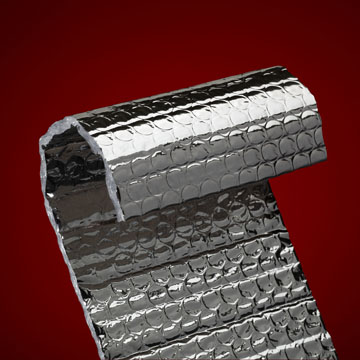 Double-pane insulated windows found on luxury RVs and upgraded lower-cost models do for an RV what they do for a home: prevent condensation on the interior side of the window. They do that with an empty pocket between the outer and inner panes that decreases temperature transfer.
Double-pane insulated windows found on luxury RVs and upgraded lower-cost models do for an RV what they do for a home: prevent condensation on the interior side of the window. They do that with an empty pocket between the outer and inner panes that decreases temperature transfer.
Tinted or reflective panes also help because they reduce interior heat buildup. That’s important because heated air holds more moisture than cooler air.
You can buy tint and fit it to the inside surface of single-pane RV windows as long as it’s permitted where you license your RV. It usually takes just scissors to trim the flexible plastic sheet, a spray bottle to apply water, and a squeegee to press the wet film onto the window.
More effective against interior heat buildup is window insulation. You can buy custom covers or make them yourself from a roll of insulated Reflectix or similar material. Place these inside or, if the weather is producing extreme, prolonged heat, outside windows when you are parked.
Measure the window and cut the Reflectix larger than the opening. You also can make a pattern out of newspaper sheets. Work in the shade; the silver finish on Reflectix can be painfully bright in sunlight. Place the cutout against the window from the inside and tuck it into place. Trim excess with a utility knife.
RV Dehumidifiers
Reduce humidity inside your RV with a dehumidifier.
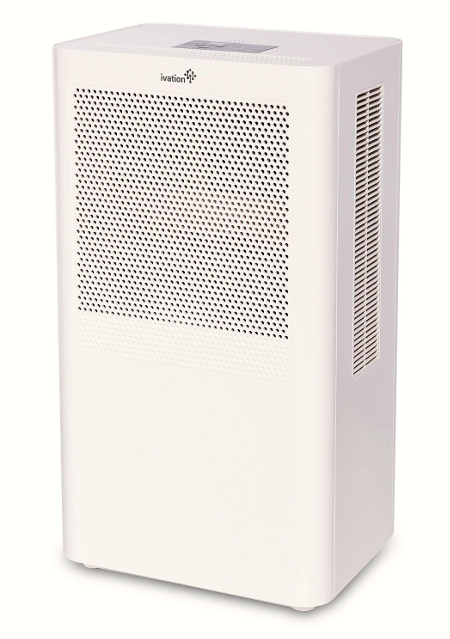 There are three kinds:
There are three kinds:
- Desiccant. Smaller desiccant dehumidifiers typically need no power to operate. They’re good for closets or cabinets but won’t handle the moisture in an entire RV. Silica gel or another moisture-absorbing desiccant pulls water from the air—maybe an ounce or two a day. When the pellets are saturated, they are discarded or recharged by plugging the unit into a wall outlet. Cost: $15-$20.
- Thermo-electric. These are great for RVs. The best choice is one that operates on either 110 or 12 volts. With no moving parts, they are quiet. Using the Peltier process, the units heat one side of a circuit board and cool the other, causing condensation to form on the cool side and drip into a plastic tank. These typically remove a pint of water a day, often less. You’ll have to empty the tank every two or three days or attach a hose for continuous draining. Cost: $35-$100.
- Condenser. Because they require 110-volt electrical service to operate, condenser dehumidifiers run only off a generator or a campsite dock. These units are noisier but can remove up to 70 pints per day. Compressed coolant in coils results in condensation that drips into a reservoir. You may have to empty daily or connect a hose for continuous drainage. Cost: $175-$200.
One more thing: Be sure to kill any mold or mildew you find with a cleaning agent containing a disinfectant.
Image Credits: Ivation, Reflectixinc.com
It’s a good time to look at gift possibilities for the RVer. Only you know best what would work for the RVer in your life — after all, you’re probably an RVer too — but here are some ideas, from leading-edge tech items to classics.
Stocking stuffer: Wineglass holder, Etsy.com
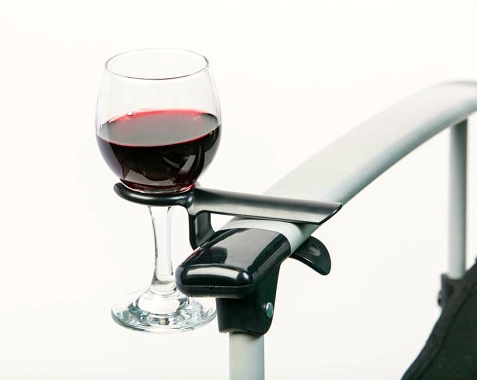
If you enjoy a little wine after dinner outside your RV, and a proper wineglass is required every bit as much as your most comfortable jeans, here’s a place to securely set down your glass. The clip-on wineglass holder works on any chair with an arm no thicker than 1 inch.
One end is a spring clip that latches securely onto the arm. The other end has plastic fingers, allowing you to slip the wineglass stem between them. The glass won’t go anywhere, which is good, since you’ll have your feet up won’t be going anywhere, either. Price: $10
RV-Compatible Grilling Set: Wayfair.com
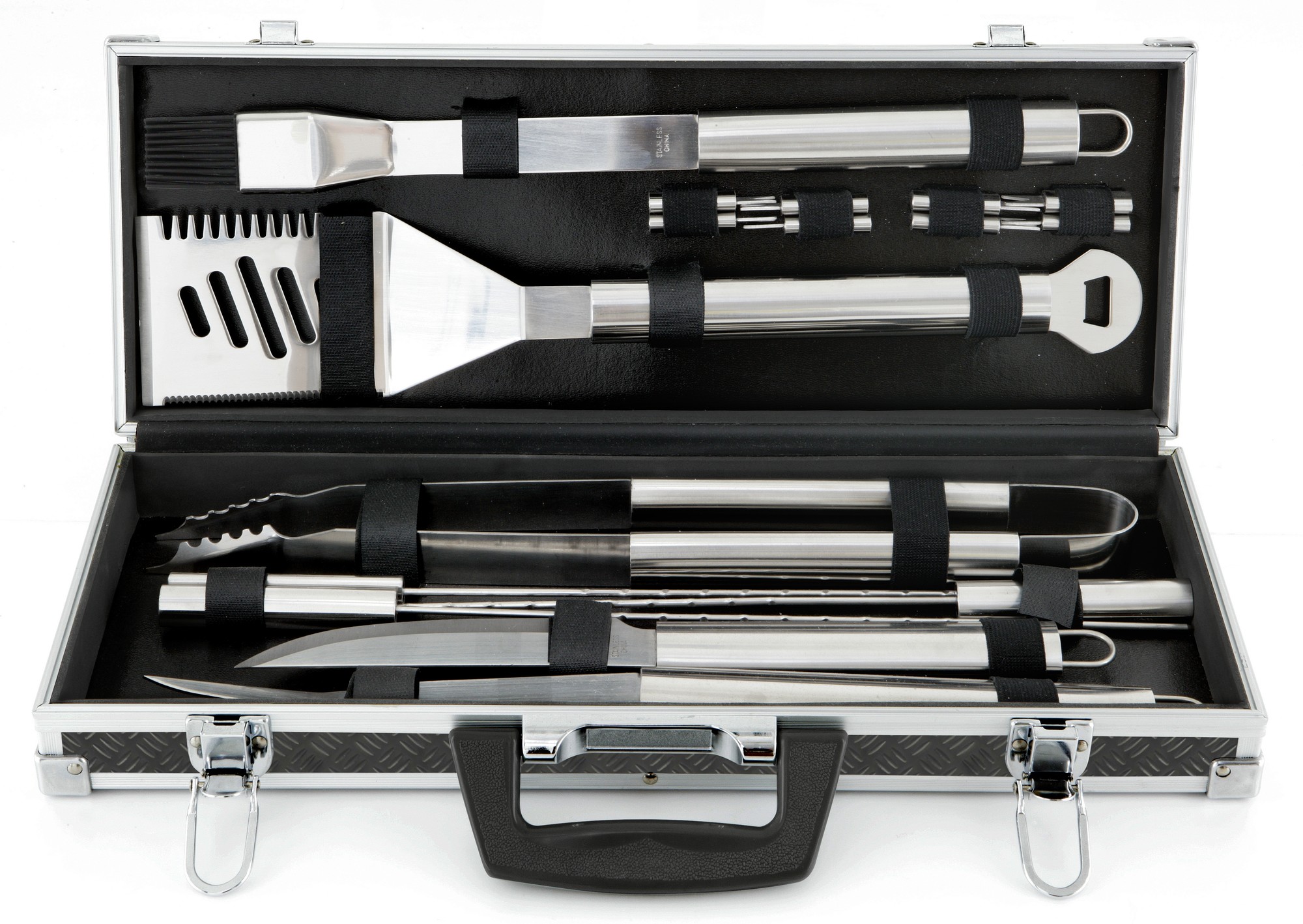
If somebody’s got to play outdoor chef — and enjoys doing it — a grilling set makes the job easier and more enjoyable. Wayfair.com has a good choice of sets, each with a compact storage case that makes RV storage easy. Some cases are hard and hinged, while others are soft and flexible. Typically you’ll find a basting brush, tongs, carving knife and fork, spatula and skewers. Some sets include steak knives, and sometimes forks, as well.
Price: $30 to $200.
Drone: DJI Mavic Pro, DroneNerds.com
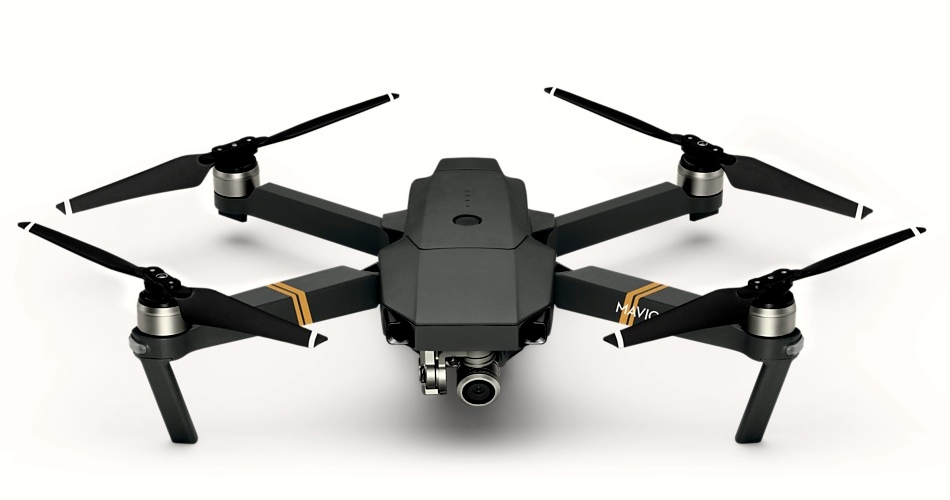
You’re taking in a fabulous view, and you think If only I could get a little higher or closer to see better. A drone does both — virtually — and shoots video at the same time. The Mavic Pro’s 4K video has four times the pixels on your 1080p TV screen. Video is shake-free because the camera is steadied by a gimbal, a small version of what stabilizes Hollywood films. Stills are 12 megapixels, and Mavic takes hands-free selfies.
The 1.6-pound Mavic Pro is great for RVs because it stores small, with foldable arms and propellers. The remote controller folds to pocket size. You see live on your smartphone what the drone sees. It has a range of 4.3 miles, and it automatically returns safely if the battery runs low. Fly over 20 minutes at up to 40 mph.
Price: $999.
Book: Travels With Charley: In Search of America, by John Steinbeck

Why recommend a book about America published 55 years ago by an author who’s since died? Well, because it documents a trip around the U.S. in a truck camper by a man and a poodle, Charley. For another, it’s by one of the country’s most celebrated writers. And it was awarded the Pulitzer Prize. For all of you who write blogs about life on the road in your RV, and all of you who wish you could, here is the original, written half a century before the Internet.
The publisher admitted more than 50 years after publication that much of this writing is fiction, but it’s interesting to read this insightful writer’s observations of the changes in America — and the fears stirred by change. Many of the problems and fears are still with us.
Price: About $6 online for a paperback, or you can spring for a rare first edition, about $110.
Travel Trailer, Fifth Wheel and MotorHome Comparison. How to Choose the Best RV For You?
Written by MattSo your imagination is in high gear, fantasizing about visiting parts of the country you’ve only flown over. Now you’re ready to visit each of those spots, stopping along the way to make sure nothing is missed.
Well, joining the RV community will help you make it happen. But first, you should ask yourself if you know what kind of RV would be best for you. There are so many types of RVs in the market that someone with no experience or first-time owners could end making a big mistake.
You could choose an RV that doesn’t fit your needs or end up just paying too much.
Here at Crossing Creeks RV Resort, we made a comparison of the leading top 3 choices of RVs in the market based on your goals and price range:
Travel Trailer
These RVs are pulled behind your vehicle and not permanently connected. They range in size from 12 to 35 feet with a cost between $8,000 and $90,000. We recommend an SUV or other 4 wheel drive vehicle to tow the trailer, to make sure the vehicle's brakes and drivetrain can support pulling this load.
One of the main benefits of the travel trailer is surely the cost. You can end up saving a lot of money and have almost the same features of a smaller motorhome regarding living space and amenities (Up to 10 people). Also, travel trailers tend to hold their value for a longer time.
One thing to be careful about is the fact that these are not as easy to drive as you may think. You need to be aware of the fact that the trailer can move and shift on the road as you’re driving, especially at highway speeds. So you need to stay focused with no distractions. For longer drives, be sure to share the driving responsibility with others who are fresh.
Fifth Wheel RV
Fifth Wheel RVs are also pulled behind your vehicle and not permanently connected. They range in size from 21 to 40 feet with a cost between $16,000 and $160,000. They need a full size truck with a bed or other 4 wheel drive vehicle to tow the trailer.
The Fifth Wheel option may be considered as the “Luxury” option when it comes to trailer selection. This vehicle can offer so many features and services and makes you feel like you’ve never left home.
Make sure to find lots of places to stop along the way so you don’t find yourself behind the wheel too long, as the heavy vehicle will surely keep your speed down. You also may be wondering about stability and safety. Good news is shifting and swaying are minimal, so you can enjoy your ride without any added stress.
MotorHome
MotorHome RVs are self-sufficient vehicles that don’t require a tow. They have their own engine, drivetrain, all integrated perfectly with the living area of the RV. They range in size from 21 to 40 feet with a cost between $60,000 and over $500,000. Some musicians and other high profile people who have to travel a lot can configure their Motorhome so that it costs over $1,000,000!
If pure luxury is what you’re looking for, MotorHomes are the best option. Space and amenities are top notch: a full kitchen area, separate bedrooms and other upgrades such as entertainment zones. These luxurious rolling homes are great for travelers who want all the creature comforts without having to worry about hotels and towing their own vehicle.
In the next blog post, we will make a comparison of the best MotorHomes models so that you can understand how to pick the right one for you. Let us know which specific model you would like us to review, and we will take it into consideration!
Storing Your RV for the Winter? Keep This Helpful Checklist Ready
Written by Super UserThe weather is changing and your happy trailing for the season has come to an end. For most RV owners, this means one thing: it is time to store the 'abode for the road' for winter. If you want to see your RV ready to roll straight out of storage next spring with little extra effort, it is important to get your RV properly prepared for storage. Here is a helpful checklist you should follow when you are getting ready to tuck away your RV for winter storage.
Each year there are more than 6,000 RV fires in the US. There may be an infinite number of ways that a motorhome can catch on fire, but there are a few common fire causes that can be easily avoided by taking proper care and maintaining your motorhome.
Spring RV Checklist - Time to Dewinterize Your Motorhome
Written by Super UserAre you getting ready to pull your RV out of storage for the season? Here is a useful checklist that you can use to ensure that your motorhome is in top condition and safe to hit the road again.
